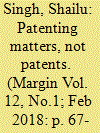|
|
|
Sort Order |
|
|
|
Items / Page
|
|
|
|
|
|
|
| Srl | Item |
| 1 |
ID:
157666


|
|
|
|
|
| Summary/Abstract |
A significant body of literature has focused on the impact of policy changes on consumption behaviour. Most of this literature looks at the impact of anticipated and durable changes, thereby ignoring the impact of unanticipated changes. In this context, exploiting a unique data set for India, the article examines the impact of a temporary ‘odd–even’ policy experiment in Delhi on second-hand car prices. The findings suggest that car prices on average, declined by 2.7 per cent after the policy announcement, although these prices subsequently recouped the initial losses. A disaggregation of car prices in terms of costs indicates that these results are driven by low-priced cars and, additionally, that cars with odd-number ending registrations commanded a premium in the market.
|
|
|
|
|
|
|
|
|
|
|
|
|
|
|
|
| 2 |
ID:
157667


|
|
|
|
|
| Summary/Abstract |
The study determines the efficiency of Indian pharmaceutical firms and its determinants in the pre- and post-product patent regime. Overall inefficiency in the industry is higher due to the inefficient conversion of inputs into output rather than through scale inefficiency. The study finds that the Product Patent Act has a negative impact on efficiency. Ownership, capital imports intensity and size variables are positively related with efficiency scores whereas age, time dummy and size square variables are inversely related. The study supports the finding that with an increase in mergers and acquisitions, a movement towards diversifying operations, the use of advanced imported foreign technology, investment in fixed assets and judicious allocation of resources for marketing activities could improve firm performance. For future policy implications, the small firms may either merge into bigger entities or manufacture pharmaceutical products for other companies, so as to raise operational scale and improve capacity utilisation.
|
|
|
|
|
|
|
|
|
|
|
|
|
|
|
|
| 3 |
ID:
157668


|
|
|
|
|
| Summary/Abstract |
The present study assesses the empirical performance of the new Keynesian IS model by estimating the standard as well as extended specifications of both the backward-looking and hybrid models in India over the period 1998Q1 to 2015Q4. It is found that the backward-looking IS model fits the data quite well in comparison with the hybrid model. The link between the policy rate and output gap appeared to be a bit stronger in the extended backward-looking IS model, as the interest rate coefficient is larger. Also, besides the interest rate, the real exchange rate, external demand and crude oil prices also have an impact on aggregate demand. The results suggest that the standard specification of the IS curve is inadequate to estimate the impact of the interest rate on aggregate demand and therefore a broader framework which accounts for additional variables besides the interest rate may be required.
|
|
|
|
|
|
|
|
|
|
|
|
|
|
|
|
| 4 |
ID:
157669


|
|
|
|
|
| Summary/Abstract |
This article looks at the association between firm market value and patenting activity in the Indian manufacturing sector, using a matched panel dataset of 380 firms spanning 22 industry groups over the period 2001–2010. To see whether the very act of patenting matters or not we introduce variation through an indicator variable indicating a firm’s patenting status, whereas to see whether having a larger number of patents matters for firm value we employ a patent stock variable. Differences in the response of firm market value to variations in these two different ways of capturing patents provide evidence for the signalling role of patents in the context of Indian manufacturing. The empirical investigations indicate that while firms that use patents to protect their innovations have a significantly higher market value than firms that do not, an increase in the number of patents granted to a firm is associated with higher market value only for firms at the lowest end of the market value distribution. The results are consistent with the explanation that patents serve as signals of firm quality.
|
|
|
|
|
|
|
|
|
|
|
|
|
|
|
|
| 5 |
ID:
157670


|
|
|
|
|
| Summary/Abstract |
This article combines two relatively nascent and inter-related approaches to poverty analysis and measurement, that is, the asset-based approach and the vulnerability approach to assess the poverty status of various land-owning classes in rural India. Contingent on the finding that marginal and small-holder households constitute a high-risk group in terms of the incidence of current poverty and vulnerability to future poverty, the study explores the role of non-agricultural activity in providing livelihood security and tackling poverty and vulnerability among land-poor rural households. The findings reveal that while most types of rural non-farm employment have significant poverty-reducing effects, human capital constitutes the most potent element in tackling poverty in the target group. We therefore suggest that an emphasis on skill upgradation of marginal and small landholders, coupled with policies directed towards development of non-farm activity, could provide an effective, permanent solution for curbing poverty and mitigating livelihood risks among these households.
|
|
|
|
|
|
|
|
|
|
|
|
|
|
|
|
|
|
|
|
|